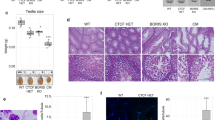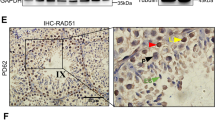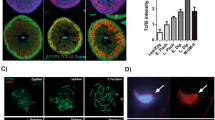Abstract
SPERMIOGENESIS is a complex process by which postmeiotic male germ cells differentiate into mature spermatozoa. This process involves remarkable structural and biochemical changes including nuclear DNA compaction and acrosome formation1,2. Tran-scriptional activator CREM (cyclic AMP-responsive element modulator) is highly expressed in postmeiotic cells3–5, and CREM may be responsible for the activation of several haploid germ cell-specific genes involved in the structuring of the spermatozoon5–7. The specific role of CREM in spermiogenesis was addressed using CREM-mutant mice generated by homologous recombination. Analysis of the seminiferous epithelium in mutant male mice reveals postmeiotic arrest at the first step of spermiogenesis. Late spermatids are completely absent, and there is a significant increase in apoptotic germ cells. We show that CREM deficiency results in the lack of postmeiotic cell-specific gene expression. The complete lack of spermatozoa in the mutant mice is reminiscent of cases of human infertility.
This is a preview of subscription content, access via your institution
Access options
Subscribe to this journal
Receive 51 print issues and online access
$199.00 per year
only $3.90 per issue
Buy this article
- Purchase on Springer Link
- Instant access to full article PDF
Prices may be subject to local taxes which are calculated during checkout
Similar content being viewed by others
References
Oakberg, E. F. Am. J. Anat. 99, 507–516 (1956).
Santen, R. J. in Endocrinology and Metabolism (eds Felig, P., Baxter, J. D., Broadus, A. E. & Frohman, L. A.) 821–905 (McGraw-Hill, New York, 1987).
Fouikes, N. S., Mellström, B., Benusiglio, E. & Sassone-Corsi, P. Nature 355, 80–84 (1992).
Foulkes, N. S., Schlotter, F., Pévet, P. & Sassone-Corsi, P. Nature 362, 264–267 (1993).
Delmas, V., van der Hoorn, F., Mellström, B., Jégou, B. & Sassone-Corsi, P. Molec. Endocr. 7, 1502–1514 (1993).
Sun, Z., Sassone-Corsi, P. & Means, A. R. Molec. cell. Biol. 15, 561–571 (1995).
Kistler, M. K., Sassone-Corsi, P. & Kistler, W. S. Biol. Reprod. 51, 1322–1329 (1994).
Laoide, B. M., Foulkes, N. S., Schlotter, F. & Sassone-Corsi, P. EMBO J. 12, 1179–1191 (1993).
Molina, C. A., Foulkes, N. S., Lalli, E. & Sassone-Corsi, P. Cell 75, 875–886 (1993).
Foulkes, N. S. & Sassone-Corsi, P. Cell 68, 411–414 (1992).
Lalli, E. & Sassone-Corsi, P. J. biol. Chem. 269, 17356–17362 (1994).
Parvinen, M. Endocr. Rev. 3, 404–417 (1982).
Perey, B., Clermont, Y. & Leblond, C. P. Am. J. Anat. 108, 47–77 (1961).
Parvinen, M. & Hecht, N. B. Histochemistry 71, 567–579 (1981).
Henriksén, K., Hakovirta, H. & Parvinen, M. Int. J. Androl. 18, 256–262 (1995).
Henriksén, K., Hakovirta, H. & Parvinen, M. Endocrinology 136, 3285–3291 (1995).
Chevrier, P. et al. EMBO J. 7, 29–35 (1988).
Lemaire, P., Relevant, O., Bravo, R. & Charnay, P. Proc. natn. Acad. Sci. U.S.A. 85, 4691–4695 (1988).
Baba, T. et al. J. biol. Chem. 269, 10133–10140 (1994).
Rubin, M. R. & Nguyen-Huu, M. C. DNA Seq. 1, 329–334 (1991).
Waeber, G. et al. Molec. Endocr. 5, 1418–1430 (1991).
Rehfuss, R. P., Walton, K. M., Loriaux, M. M. & Goodman, R. H. J. biol. Chem. 266, 18431–18434 (1991).
Chrivia, J. C. et al. Nature 365, 855–859 (1993).
Desdouets, C. et al. Molec. cell. Biol. 15, 3301–3309 (1995).
Chaganti, R. S. K. & German, J. Am. J. hum. Genet. 31, 634–641 (1979).
Micic, M., Nikolis, J. & Micic, S. Hum. Reprod. 7, 1118–1120 (1992).
Kleene, K. C., Distel, R. J. & Hecht, N. B. Biochemistry 24, 719–722 (1985).
Johnson, P. A., Peschon, J. J., Yelick, P. C., Palmiter, R. D. & Hecht, N. B. Biochim. biophys. Acta 950, 45–53 (1988).
Kleene, K. C., Borzorgzadeh, A., Flynn, J. F., Yelick, P. C. & Hecht, N. B. Biochim. biophys. Acta 950, 215–220 (1988).
Kleene, K. & Flynn, J. F. J. biol. Chem. 262, 17272–17277 (1987).
Author information
Authors and Affiliations
Rights and permissions
About this article
Cite this article
Nantel, F., Monaco, L., Foulkes, N. et al. Spermiogenesis deficiency and germ-cell apoptosis in CREM-mutant mice. Nature 380, 159–162 (1996). https://doi.org/10.1038/380159a0
Received:
Accepted:
Issue Date:
DOI: https://doi.org/10.1038/380159a0
This article is cited by
-
Spermiogenesis of the hangingfly Terrobittacus implicatus (Huang and Hua) (Mecoptera: Bittacidae)
Protoplasma (2019)
-
Differential regulation of spermatogenic process by Lkb1 isoforms in mouse testis
Cell Death & Disease (2017)
-
Effects of different kinds of essentiality on sequence evolution of human testis proteins
Scientific Reports (2017)
-
SOX30 is required for male fertility in mice
Scientific Reports (2017)
-
Effects of Fluoride on Expression of P450, CREM and ACT Proteins in Rat Testes
Biological Trace Element Research (2017)
Comments
By submitting a comment you agree to abide by our Terms and Community Guidelines. If you find something abusive or that does not comply with our terms or guidelines please flag it as inappropriate.



